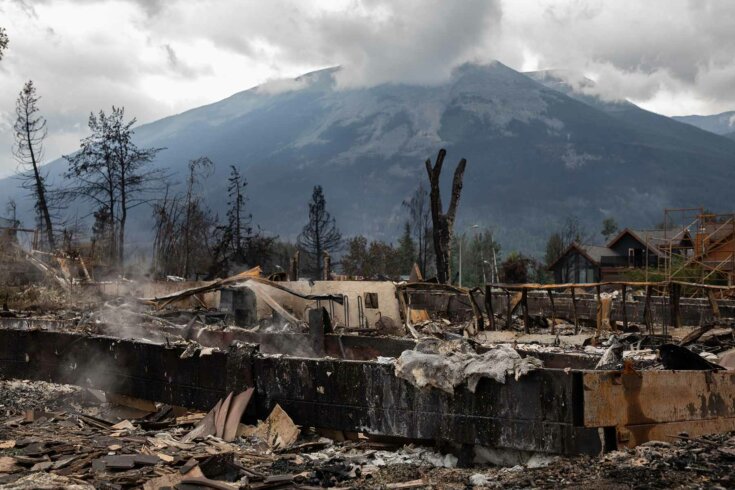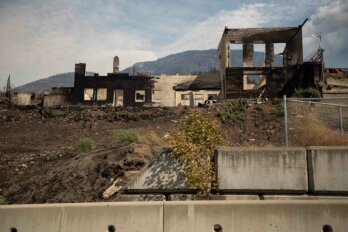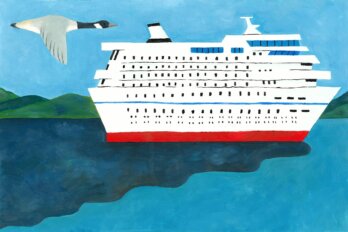We know the sight: neighbourhoods reduced to smoking foundations. Trees like crisp skeletons. Families packed into cars jamming the only available route out of town, fleeing at a crawl beneath orange-black skies. Surrounding it all, the cause of it all, an unstoppable wall of fire.
On July 24, Jasper became the latest member of this era’s new Hall of Flame, joining towns and cities it suddenly resembles: Fort McMurray, Lytton, West Kelowna. Jasper National Park is best known for the azure lakes and mountain trails and glaciers that draw more than 2 million visitors a year. It’s also a permanent home to more than 4,000 people who just lost a third of their town. That none of them lost their lives commands acknowledgement and gratitude. That such a unique place could so quickly be transformed into a common sight demands reflection—and a reckoning.
Even for those who don’t live there, Jasper is more than a “tourist destination.” To be a tourist is to drop in, snap a few pictures, hike a trail or two, and move on. The traveller’s equivalent of a one-night stand. But the vast outpouring of grief that followed Jasper’s incineration revealed something far deeper: a long-term relationship, profound and vulnerable. That bond is with the townsite and the landscape it’s embedded in—a place where human habitation and the surrounding wilderness are interwoven. Just as people walk through Maligne Canyon or hike the Skyline Trail, herds of elk regularly stroll down Connaught Drive, while itinerant black bears snack their way through backyards. Golfers at Jasper Park Lodge share the fairway with deer and Canada geese.
I grew up four hours away, in Edmonton. The first mountain I ever stood on top of was in Jasper National Park: Roche Miette, whose summit resembles a long-chinned face staring up at the sky. I hiked up with a friend in high school on a day that started out sunny. By the time we reached the top, thunderclouds were closing in from all sides; our subsequent descent was an exquisitely miserable slosh that I’ll never forget. Nearby is Lake Edith, where my mother’s late partner had a family cabin. His family remains close to ours, and that property is still part of our lives. At least, it was. Lake Edith fell within the wildfire’s path of destruction, and as I write, the family’s still waiting to learn if the structure, which is so much more than just a structure, survived.
In an urbanized world, where “nature” is partitioned off from daily life and reality is filtered through a screen, these relationships with the land represent an endangered category of love. And what could be more human than taking it for granted until it’s gone?
The vein of grief laid bare in Jasper’s aftermath caught many by surprise. The most striking example came from the last person I’d have expected: Alberta premier Danielle Smith, not a politician known for sentimentality or environmental concern. Yet when she addressed the public one day after fire swept through town, as uncontrolled flames still raged through the surrounding forest, tears overwhelmed her. They started welling up as she spoke of the families who’d lost their homes and businesses. Then she invoked “the magic of Jasp—” and couldn’t quite finish the word. She broke down.
The dissonance was galling. Few Canadians have done more to promote fossil fuels—a root cause of the catastrophe she was mourning—than Smith. She has spent her career belittling the very notion of environmental crisis. Her government has actively promoted mining other sections of the Rockies for coal. But maybe, in a moment when everything feels like it’s cracking open, it’s okay to extend her a moment’s grace. Emma Gilchrist interpreted Smith’s emotional address as a sign of hope. “In these divided times, we need to spend less time looking for what separates us and more time looking for what unites us,” Gilchrist wrote in The Narwhal after seeing Smith speak. In the premier’s tears, Gilchrist saw a reverence for nature—that “magic” of Jasper—which “transcends political parties, policies and posturing.”
Still, a reckoning must come. The question must be asked, and not just of Smith: What now? Rebuilding a town every year isn’t enough. Jasper is not alone in occupying what fire experts call the “wildland–urban interface,” or WUI. This niche term’s been percolating into the popular discourse lately, for obvious reasons. As John Vaillant writes in Fire Weather: The Making of a Beast, a harrowing page turner about the 2016 Fort McMurray blaze: “On a map, the WUI represents the fault line between the forest and the built environment, but over the past thirty years it has also come to represent the sweet spot in North American real estate development: hiking trails out the back door and a scooter-friendly cul-de-sac in front.”
Because that fault line has become so fuzzy (there’s never a clear line where a community ends and a forest begins), precise statistics on Canadians’ exposure are impossible to nail down. One peer-reviewed study found that 12 percent of Canadians, and 32 percent of on-reserve First Nations, live in the WUI. That’s over 4 million people, but it almost certainly understates our collective vulnerability. According to the Canadian Partnership for Wildland Fire Science, 60 percent of all human habitations in Canada have “a significant amount of WUI,” defined as more than 500 hectares of WUI within a five-kilometre radius.
We inhabit one of the most forested nations on earth. That forest is getting more flammable every year, for a number of overlapping reasons: climate change, absolutely, but a century of fire suppression, industrial forestry, and urban sprawl all play big roles too. Under-resourced fire departments, compounded by jurisdictional confusion between provincial and federal authorities, add more layers of complexity. However you apportion blame, the calamity Jasper just endured is no longer unthinkable. For millions of Canadians, it’s impossible not to think that it’s coming for us next.
This isn’t a Canadian crisis, or even a North American one. It’s universal—from Hawaii to Australia, Greece to Brazil. The sickening sequence of heat wave–ignition–conflagration has become a staple of the summer news cycle. And that’s for the lucky ones who aren’t being evacuated or breathing in the smoke.
That context matters. The problem with zooming out like that, though, is it turns the problem into a concept. At a planetary scale, everything’s abstract. The world isn’t just too big to save, it’s too big to understand—which means it’s too big to care about. To really care for something or someone, you need a relationship with them. That’s a matter of intimacy. In Jasper, ecological crisis stopped being an idea and became a tragedy. This is one answer that comes to me as I wonder what we can learn from Jasper: big as it is in our minds, it’s small enough to love.
More Jaspers will burn. Some will be iconic. Most won’t. Most of the land that burns goes unseen, along with some of its non-human inhabitants. But when a place that’s touched so many people burns, there’s an opportunity for it to be more than a disaster. The same flames that destroy a beloved place can also ignite something good in our collective: a recognition, crystallized by grief, that many of the things we hold dear, we also hold in common.
With thanks to the Trottier Foundation for helping The Walrus publish writing on climate change and the environment.





